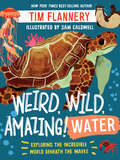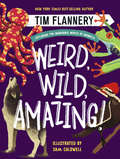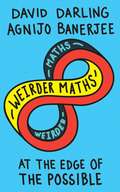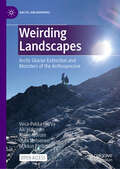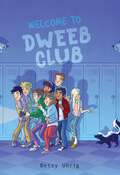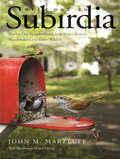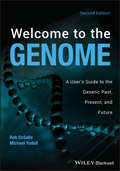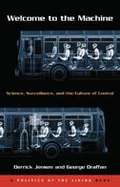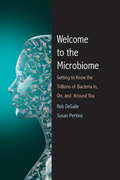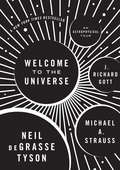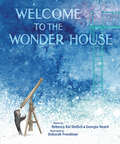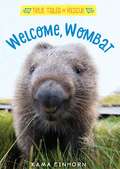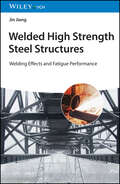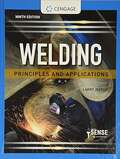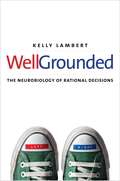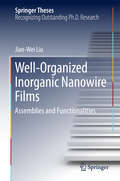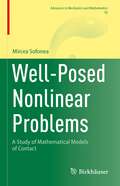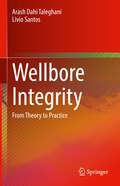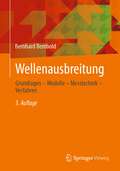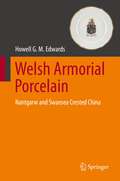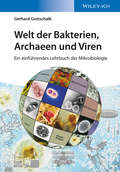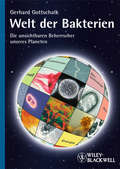- Table View
- List View
Weird, Wild, Amazing! Water: Water
by Tim FlanneryInternationally renowned author and scientist Tim Flannery explores our planet’s rivers and oceans and the extraordinary animals that live in them. Can jellyfish become zombies? Are narwhals unicorns? Can a turtle live in a tree? Tim Flannery has the answers. In this informed and accessible book, he introduces some of the most spectacular and unusual creatures in Earth’s waters with in-depth and often bizarre facts. Flannery ties together concepts of climate change, evolution, conservation, and taxonomy throughout each animal’s profile, firmly connecting it to its environment while sparking wonder at its role in the natural world. Packed with vibrant illustrations and guided by real-life anecdotes from one of our greatest science communicators, Weird, Wild, Amazing! Water teaches readers to cherish and delight in our planet’s ecosystems with Tim Flannery’s signature mix of humor and wisdom.
Weird, Wild, Amazing!: Exploring The Incredible World Of Animals
by Tim FlanneryInternationally renowned author and scientist Tim Flannery’s first children’s book is a humorous, informed, and accessible deep-dive into the natural world. Are zombie jellyfish real? Do frogs like opera? What’s it like to wrestle a python? Tim Flannery has the answers. Introducing some of the most spectacular and unusual creatures on Earth, from water to sky and the forests and deserts in between, he offers in- depth and often bizarre facts on extraordinary animals that live in each habitat while incorporating concepts of climate change, evolution, conservation, and taxonomy. Did you know that lions once roamed North America, or that albatrosses sleep-fly? Have you ever heard a piranha bark, or ever wondered how the sloth got its name? Packed with vibrant illustrations and guided by real-life anecdotes from one of our greatest science communicators, Weird, Wild, Amazing! teaches readers to cherish and delight in our planet’s environment with Flannery’s signature mix of humor and wisdom.
Weirder Maths: At the Edge of the Possible
by David Darling Agnijo BanerjeeEven the most enthusiastic of maths students probably at one time wondered when exactly it would all prove useful in &‘real life&’. Well, maths reaches so far and wide through our world that, love it or hate it, we&’re all doing maths almost every minute of every day. David Darling and Agnijo Banerjee go in search of the perfect labyrinth, journey back to the second century in pursuit of &‘bubble maths&’, reveal the weirdest mathematicians in history and transform the bewildering into the beautiful, delighting us once again.
Weirding Landscapes: Arctic Glacier Extinction and Monsters of the Anthropocene (Arctic Encounters)
by Roger Norum Vesa-Pekka Herva Oula Seitsonen Markus Fjellström Aki HakonenThis open access book investigates human-environment relations in the context of the anthropocenic Arctic. Through an archaeological and anthropological study of landscape, it wields “weirding” – a creative mode of engagement with the world – as a means of coming to terms with the stranger, experiential dimensions of a planet populated by diverse non-human entities often bearing monstrous characteristics. Such entities are exemplified by climate change itself, at once human-induced and a force of its own volition that maintains an elusive “presence” as a co-inhabitant of the Anthropocene. The book focuses on the landscape of Ritničohkka, a fjell in Sápmi, Finnish Lapland. Ritničohkka is erstwhile home to a diminutive “glacier”, whose “weird”, anomalous characteristics crowned the fjell until it several years ago melted into history. Taking a broadly autoethnographic approach, it considers perceptions of, and affective experiences in, this rough and relatively remote, “otherworldly” environment, discussing diverse ways of encountering and relating to the Arctic in the context of scientific fieldwork.
Welcome Home: Where Nature's Most Creative Creatures Dwell
by Lisa MundorffIn Lisa Mundorff's Welcome Home, young readers will delight in the realistic and literal interpretations of where some of our most favorite animals live. Humans love to put their feet up at home after a long day--whether they're in a house, apartment, or cabin. Well, even animals have their own particular homes. Otters kick it on a couch, lions retreat to their dens, and pigeons (the city dwellers that they are) call lofts their home.Where we live is a part of us.
Welcome to Dweeb Club
by Betsy UhrigFor fans of Gordon Korman comes a hilarious, heartfelt middle grade adventure about a school club whose members stumble across video footage of themselves from five years in the future.What if a school club changed your life forever? In the second week of seventh grade, Jason Sloan signs up for the brand-new HAIR Club. He and his friends have no idea what it&’s about, but since they&’re the first to sign up they figure they&’ll be in charge in no time. The club turns out to be super weird: using fancy new equipment donated by a mysterious benefactor, the members are supposed to monitor school security footage. Their first assignment: find out what is stealing the cafeteria&’s croutons. Instead of the expected dark cafeteria, the computers show the club members something else entirely: actual footage of themselves as high school seniors, five years in the future! What on earth could be happening? Is it some kind of time warp, or alternate reality? Or is it just an un-funny prank? As they scramble to solve the mystery, they can&’t help but notice something else—none of them like what they see five years from now. Is there any way to change the future—and their fates? Figuring out who you are and who you want to become has never been funnier in this laugh-out-loud romp through the perils of middle school—and beyond.
Welcome to Subirdia
by John M. Marzluff Jack DelapWelcome to Subirdia presents a surprising discovery: the suburbs of many large cities support incredible biological diversity. Populations and communities of a great variety of birds, as well as other creatures, are adapting to the conditions of our increasingly developed world. In this fascinating and optimistic book, John Marzluff reveals how our own actions affect the birds and animals that live in our cities and towns, and he provides ten specific strategies everyone can use to make human environments friendlier for our natural neighbors. Over many years of research and fieldwork, Marzluff and student assistants have closely followed the lives of thousands of tagged birds seeking food, mates, and shelter in cities and surrounding areas. From tiny Pacific wrens to grand pileated woodpeckers, diverse species now compatibly share human surroundings. By practicing careful stewardship with the biological riches in our cities and towns, Marzluff explains, we can foster a new relationship between humans and other living creatures-one that honors and enhances our mutual destiny.
Welcome to the Genome: A User's Guide to the Genetic Past, Present, and Future
by Michael Yudell Robert DeSalleThe popular introduction to the genomic revolution for non-scientists—the revised and updated new edition Welcome to the Genome is an accessible, up-to-date introduction to genomics—the interdisciplinary field of biology focused on the structure, function, evolution, mapping, and editing of an organism's complete set of DNA. Written for non-experts, this user-friendly book explains how genomes are sequenced and explores the discoveries and challenges of this revolutionary technology. Genomics is a mixture of many fields, including not only biology, engineering, computer science, and mathematics, but also social sciences and humanities. This unique guide addresses both the science of genomics and the ethical, moral, and social questions that rise from the technology. There have been many exciting developments in genomics since this book's first publication. Accordingly, the second edition of Welcome to the Genome offers substantial new and updated content to reflect recent major advances in genome-level sequencing and analysis, and demonstrates the vast increase in biological knowledge over the past decade. New sections cover next-generation technologies such as Illumina and PacBio sequencing, while expanded chapters discuss controversial ethical and philosophical issues raised by genomic technology, such as direct-to-consumer genetic testing. An essential resource for understanding the still-evolving genomic revolution, this book: Introduces non-scientists to basic molecular principles and illustrates how they are shaping the genomic revolution in medicine, biology, and conservation biology Explores a wide range of topics within the field such as genetic diversity, genome structure, genetic cloning, forensic genetics, and more Includes full-color illustrations and topical examples Presents material in an accessible, user-friendly style, requiring no expertise in genomics Discusses past discoveries, current research, and future possibilities in the field Sponsored by the American Museum of Natural History, Welcome to the Genome: A User's Guide to the Genetic Past, Present, and Future is a must-read book for anyone interested in the scientific foundation for understanding the development and evolutionary heritage of all life.
Welcome to the Machine: Science, Surveillance and the Culture of Control
by Derrick Jensen George Draffan[Back Cover[ Tiny ID chips track every car, shirt, and razor blade purchased from corporate manufacturers. Governments and multinational corporations gather information on every citizen's race, family life, credit record, buying preferences, employment history, favorite TV shows, telephone conversations-and can surreptitiously peruse e-mails. Exoskeleton armor makes soldiers invincible, while mind-altering drugs make them incapable of remorse. In Welcome to the Machine, award-winning authors Derrick Jensen and George Draffan reveal the modern culture of the machine, where corporate might makes technology right, government money feeds the greed for mad science, and absolute surveillance leads to absolute control. Through meticulous research and fiercely personal narrative, Jensen and Draffan move beyond journalism and expose to question our civilization's very mode of existence. Welcome to the Machine challenges our submission to the institutions and technologies built to rob us of all that makes us human-our connection to the land, our kinship with one another, our place in the living world.
Welcome to the Microbiome
by Rob Desalle Patricia J. Wynne Susan L. PerkinsSuddenly, research findings require a paradigm shift in our view of the microbial world. The Human Microbiome Project at the National Institutes of Health is well under way, and unprecedented scientific technology now allows the censusing of trillions of microbes inside and on our bodies as well as in the places where we live, work, and play. This intriguing, up-to-the-minute book for scientists and nonscientists alike explains what researchers are discovering about the microbe world and what the implications are for modern science and medicine. Rob DeSalle and Susan Perkins illuminate the long, intertwined evolution of humans and microbes. They discuss how novel DNA sequencing has shed entirely new light on the complexity of microbe-human interactions, and they examine the potential benefits to human health: amazing possibilities for pinpoint treatment of infections and other illnesses without upsetting the vital balance of an individual microbiome. This book has been inspired by an exhibition, The Secret World Inside You: The Microbiome, at the American Museum of Natural History, which will open in New York in early November 2015 and run until August 2016. It will then travel to other museums in the United States and abroad.
Welcome to the Universe: An Astrophysical Tour
by Neil Degrasse Tyson J. Richard Gott Michael A. StraussWelcome to the Universe is a personal guided tour of the cosmos by three of today's leading astrophysicists. Inspired by the enormously popular introductory astronomy course that Neil deGrasse Tyson, Michael A. Strauss, and J. Richard Gott taught together at Princeton, this book covers it all--from planets, stars, and galaxies to black holes, wormholes, and time travel.Describing the latest discoveries in astrophysics, the informative and entertaining narrative propels you from our home solar system to the outermost frontiers of space. How do stars live and die? Why did Pluto lose its planetary status? What are the prospects of intelligent life elsewhere in the universe? How did the universe begin? Why is it expanding and why is its expansion accelerating? Is our universe alone or part of an infinite multiverse? Answering these and many other questions, the authors open your eyes to the wonders of the cosmos, sharing their knowledge of how the universe works.Breathtaking in scope and stunningly illustrated throughout, Welcome to the Universe is for those who hunger for insights into our evolving universe that only world-class astrophysicists can provide.
Welcome to the Wonder House
by Georgia Heard Rebecca Kai DotlichThis collection of poems, creatively presented in the format of an allegorical house, will engage anyone who has ever wondered &“why?&” as it shows young readers that wonder is everywhere—in yourself and in the world around you.Welcome to the Wonder House, a place to explore the cornerstone of every great thinker—a sense of wonder. This Wonder House has many rooms—one for nature, one for quiet, and one for mystery, among others. Each room is filled with poems and objects covering a wide variety of STEAM topics, including geology, paleontology, physics, astronomy, creative writing, and drawing, that will inspire curiosity in young readers.This enchanting book written by award-winning poets Rebecca Kai Dotlich and Georgia Heard both sparks wonder and shows readers how to kindle it in themselves.
Welcome, Wombat (True Tales of Rescue)
by Kama EinhornPhoto-packed series explores the stories and science behind animal sanctuaries. An up-close look at what life is like at a real wombat sanctuary in Australia—straight from a wombat herself in a nonfiction chapter book for elementary-aged readers. Includes full-color photos, graphics, and maps.When a new baby wombat shows up at Sleepy Burrows Sanctuary in Australia, Chance, the veteran wombat, is excited to show the new gal the ropes. Before any animal can be successfully released, many things have to happen. After rescue comes recovery, then rehabilitation, and finally, release. Those are animal-sanctuary tenets—an animal will remain safe until release or until it dies. For Chance and the new wombat, Panzer, this means learning how to find food, dig, and find a lifelong companion. Readers will love Chance, Panzer, and the crew of wombats. Other books in the photo-packed Sanctuary Stories series include Sweet Senior Pups.
Welded High Strength Steel Structures: Welding Effects and Fatigue Performance
by Jin JiangWelded High Strength Steel Structures Understand the impact of fatigue on high strength steel joints with this comprehensive overview High strength steels are highly sought after for industrial and engineering applications ranging from armored vehicles to welded engineering components built to withstand considerable stress. The mechanical properties of welded joints made from high strength steel are integrally linked to the specific welding process, which can have an enormous impact on fatigue performance. Welded High Strength Steel Structures: Welding Effects and Fatigue Performance provides a comprehensive analysis of high strength steel joints and the ramifications of the welding process. It guides readers through the process of performing thermal analysis of high strength steel structures and evaluate fatigue performance in the face of residual stress. The result is a volume with innumerable use cases in engineering and manufacture. Welded High Strength Steel Structures readers will also find: An author with decades of experience in research and engineering Numerous studies of various classes of high strength steel joints Studies on tubular structures for welding residual stress Welded High Strength Steel Structures is a must-own for welding specialists, materials scientists, mechanical engineers, and researchers or industry professionals in related fields.
Welding (Fundamentals of Service Series)
by Deere Company StaffThe main purpose of this manual is to explain the different types of welding processes, cutting, brazing, soldering, surfacing, design of welds, properties of metals and welding safety. For the novice, this manual is a training guide. All-new welding projects at the end of the book augment this training. For the journeyman, it is a reference. This manual can be used by anyone -- experienced mechanics and shop trainees; as well a vocational students and interested laymen. It starts with the basics and builds your knowledge step-by-step in a very structured manner, making the information easy to understand.
Welding: Principles and Applications
by Larry JeffusThis proven guide provides the knowledge and skills you need to complete AWS SENSE Level I and Level II programs, create Workmanship Qualification Specimens, and earn professional certification. Advancing rapidly from basic concepts and processes to today s most complex, cutting-edge welding technologies and practices, this comprehensive text features valuable information on topics such as welding metallurgy, metal fabrication, weld testing and inspection, joint design, job costing, and environmental and conservation tips. <p><p>The author opens each section by introducing you to the materials, equipment, setup procedures, and critical safety information you need to execute a specific process successfully, while subsequent chapters focus on individual welding tasks leading to SENSE certification. <p><p>In addition to hundreds of new photos showcasing current welding tools and techniques, the Ninth Edition includes new and updated information on GTAW cup walking, induction welding machine operations, innovations in PAC equipment, and other industry advances you are likely to encounter as you begin your career as a welding professional.
Well-Grounded: The Neurobiology of Rational Decisions
by Kelly LambertA neuroscientist reveals unique aspects of decision making and the best strategies for protecting and enhancing the brain’s ability to navigate life’s uncertainties Contingency calculations—the ability to predict the outcomes of decisions and actions—are critical for survival and success. Our amazing brains continually process past and current experiences to enable us to make the most adaptive choices. But when the brain’s information systems are compromised—by such varying conditions as drug addiction, poverty, mental illness, or even privilege—we can lose the ability to arrive at informed decisions. In this engaging book, behavioral neuroscientist Kelly Lambert explores a variety of the modern factors that can lead to warped neural processing, or distorted realities she terms “brain bubbles.” Individuals who define success in terms of creature comforts and immediate gratification, for instance, may interact less with the physical and social world and thereby dull their ability to imagine varied contingency scenarios. The author underscores how continuous, meaningful, and well-grounded experiences are required if we are to make the best decisions throughout our lives.
Well-Organized Inorganic Nanowire Films
by Jian-Wei LiuThis thesis presents the latest findings on macroscopic-scale nanowire thin films composed of integrated nanowires. It introduces readers to essential synthesis and assembly strategies for the design and fabrication of high-quality nanowire thin films, and discusses their underlying principles in detail. The book highlights examples specific to well-aligned nanowire systems, and explores the applications of nanowire systems, including memory devices, flexible transparent electrodes, etc. The book offers a valuable resource for researchers and graduate students working in materials science, especially in nanowire device fabrication.
Well-Posed Nonlinear Problems: A Study of Mathematical Models of Contact (Advances in Mechanics and Mathematics #50)
by Mircea SofoneaThis monograph presents an original method to unify the mathematical theories of well-posed problems and contact mechanics. The author uses a new concept called the Tykhonov triple to develop a well-posedness theory in which every convergence result can be interpreted as a well-posedness result. This will be useful for studying a wide class of nonlinear problems, including fixed-point problems, inequality problems, and optimal control problems. Another unique feature of the manuscript is the unitary treatment of mathematical models of contact, for which new variational formulations and convergence results are presented. Well-Posed Nonlinear Problems will be a valuable resource for PhD students and researchers studying contact problems. It will also be accessible to interested researchers in related fields, such as physics, mechanics, engineering, and operations research.
Wellbore Integrity: From Theory to Practice
by Arash Dahi Taleghani Livio SantosThere have been concerns about the integrity of thousands of wells drilled worldwide for different purposes ranging from oil and gas to geological carbon sequestration. This is the first book to integrate different aspects of wellbore integrity into a single volume. It looks at the energy sector's green wave movement by expanding an important topic for practitioners, regulators, and students. It is an area where petroleum and subsurface engineers will increasingly need to be involved in the future to address growing expectations regarding environmental impacts and sustainability. Coverage also includes recent developments in regulations and R&D with indications on emerging areas.Wellbore Integrity: From Theory to Practice will be a valuable resource for practicing engineers and students working on problems related to subsurface energy, subsurface disposals, and environmental impacts of oil and gas wells. In parallel, it will be a valuable reference for engineers and scientists interested in repurposing existing wells for carbon sequestration or geothermal purposes.
Wellenausbreitung: Grundlagen – Modelle – Messtechnik – Verfahren
by Bernhard RemboldDas Lehrbuch vermittelt dem Leser grundlegende Kenntnisse über das, was zwischen Sende- und Empfangsantenne geschieht, da sie für eine plangemäße Funktion entscheidend sind. Die Wellenausbreitung bestimmt maßgebend die Übertragungsverfahren in der Funkkommunikation und beeinflusst in vielen HF-Anwendungen die Systemauslegung. Ziel des Buches ist, dem Leser diese Kenntnisse zu vermitteln sowie ihn in die Lage zu versetzen, Probleme und Möglichkeiten in Zusammenhang mit der Wellenausbreitung zu verstehen und beurteilen zu können.
Welsh Armorial Porcelain: Nantgarw and Swansea Crested China
by Howell G. EdwardsArmorial porcelains comprised the output of most European ceramics factories in the 18th and 19th Centuries in response to the large quantity of armorial porcelain services that were being imported from China bearing the coats of arms and crests of aristocratic families. Whereas these armorial services have been identified and covered for most porcelain manufactories the information relevant to their production by the two relatively short-lived Nantgarw and Swansea China Works has not been addressed as a theme until now. As an integral component of the holistic forensic appraisal of porcelain, a functional and decorative artwork manifestly part of our cultural heritage and its ongoing preservation , the recording and identification of such artefacts is material for the future establishment of a database of factory production . The Nantgarw and Swansea factories only operated for a limited period in the second decade of the 19th Century and their porcelains were much appreciated for their high quality and desirability by Georgian households. Today, examples are to be found in many museums and ceramics collections and continue to excite the interest of specialists and the general public . This text provides the first comprehensive assessment of armorial porcelains from these two factories and the methodology and procedure for the identification of unknown armorial bearings and crests is illustrated; individual bearings are discussed in detail and existing incorrect assignments in the literature are re-appraised. The difficulties in attribution of armorial heraldic achievements that are only minimally depicted are considered and directions for further studies using historical documentation are invoked. This book therefore fills a currently existing gap in the ceramics literature of the 19th Century.
Welt der Bakterien, Archaeen und Viren: Ein einführendes Lehrbuch der Mikrobiologie
by Gerhard GottschalkZeitgemasses Wissen in Lekture- und in Lehrbuchform. Gerhard Gottschalk vermittelt die Mikrobiologie in ihrer ganzen Breite. In 12 Teilen mit jeweils mehreren Kapiteln wird die Mikrobiologie dem Leser auf sehr verstandliche Weise nahergebracht. <P><P>Jedes Kapitel besteht aus einer leicht zu lesenden Beschreibung und darauf abgestimmter Lerneinheit samt Fragenkatalog. Daruber hinaus enthalten die meisten Kapitel Beitrage beruhmter Wissenschaftler auf dem entsprechenden Gebiet. Historische Durchbruche werden beschrieben und so den Studierenden Einblicke in Denk- und Planungsstrukturen von wissenschaftlichem Arbeiten vermittelt. So beschreibt beispielsweise Stefan Hell seine 2014 mit dem Nobelpreis gekronte STED-Mikroskopie. Alle wichtigen Gebiete der Mikrobiologie, von der Evolution uber den mikrobiellen Stoffwechsel und die technischen Anwendungen bis hin zum Gentransfer, zu den Endosymbionten und den Pathogenen werden abgedeckt. Auch wird den Archaea und den Viren entsprechend ihrer enormen Bedeutung ein eigener Teil gewidmet. Das Buch ist ein perfekter Begleiter fur die einfuhrende Vorlesung "Allgemeine Mikrobiologie" sowie ein hervorragender Studienbegleiter fur alle Naturwissenschaftler und Ingenieure, die Mikrobiologie als Nebenfach belegen.
Welt der Bakterien: Die unsichtbaren Beherrscher unseres Planeten
by Gerhard GottschalkWritten in dialog form, Gerhard Gottschalk's book provides surprising insights into the amazing world of bacteria. These microorganisms have changed the Earth more than any other life form and turned it into an inhabitable planet. Did you know, for example, that the human body contains more bacteria cells than human ones? Or that in each animal and plant cell the remains of former symbiotic bacteria maintain the metabolism? But bacteria also have their negative aspects: they cause illnesses and produce the strongest toxins known to mankind. Backed by more than 45 contributions from famous international scientists written especially for this book.
